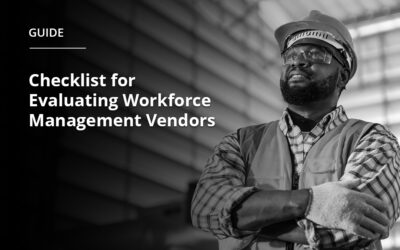Time and Attendance Management: Best Implementation Strategies for Your Organisation

Efficient time and attendance management can transform your organisation, boosting productivity and employee satisfaction. Addressing these challenges ensures your employees feel valued and their privacy respected.
Each organisation has unique personnel needs and specific requirements. It’s easy to determine whether your company could benefit from these programs with a few simple questions:
- Can your existing system handle complex labour laws, pay rules and current contract agreements? Not all programs are sophisticated or agile enough to navigate these compliance issues.
- Is this system providing a positive experience for your employees? Your chosen platform should benefit your workers, enabling them to clock in, view their records and communicate with management about any complications with attendance.
- Is your system making your organisation more efficient? If it requires extensive administrative involvement or doesn’t provide accurate time capture, your time and attendance program could cost your business more than it’s helping.
Once you answer these questions, evaluate time and attendance software that can help streamline and automate the process. This minimises work hours for evaluation and ensures fairness and accuracy through proper transparency.
Revisit Data and Processes
The first step to improving time and attendance management is finding areas that need improvement. Shift changes, when large numbers of employees are clocking in/out simultaneously, are often the most obvious pain point. However, there are other important points to consider. Documentation can involve hundreds of employees and years of attendance records.
Identifying trends amid this data can even more be time-consuming and inefficient. Workforce management software can gather and organise data on time and attendance for each employee, audit attendance rules and find where issues are likely to occur. This includes systemic inefficiencies and DIY solutions used as workarounds. Effective workforce management software can seamlessly integrate into your existing processes.
Automation is powerful but not a magic solution. Knowing when to use manual processes versus automation is essential. Repetitive and tedious tasks should be automated or supported by AI (Artificial Intelligence). With accurate data and an understanding of system improvements, you can plan the right implementation strategy.
Set Expectations
Once areas of improvement have been identified, they can be aligned with the company’s overall plan. Goals can be defined with realistic expectations and measurable milestones laid out to chart progress.
Next, set key performance indicators (KPIs) — like increased productivity or lowering costs — and have a solid idea of the time and resources it will take to achieve each goal. Subsequent planning and execution are apt to be much more effective.
With expectations defined, discuss policies and procedures for time off requests, attendance monitoring, rewards, disciplinary action and compliance with state and federal laws. Standard methods of conveying company-wide information, like company-wide meetings, emails, or handouts, are necessary. However, ongoing employee feedback is crucial for identifying problems and correcting courses.
Employees may offer valuable insights into potential trouble spots. Allowing employees to contribute to the system increases their sense of ownership and loyalty to the company, boosting employee engagement and satisfaction.
Promote Work-Life Balance
Work-life balance is important for employee loyalty and retention and is especially important for sectors like manufacturing and healthcare that depend upon skilled and experienced workers. A loyal employee who knows how the organisation runs can translate to cost savings in recruitment, hiring, training and retention.
Time and attendance management systems can promote work-life balance by limiting overtime. How you implement the system will make all the difference. Overtime can cause irregular hours, payroll issues and heightened stress. Limiting overtime encourages employees to finish work on time and spend more time on personal interests, reducing burnout and improving attendance.
Make it Accessible
Transparency and accessibility are integral to any organisation’s time and attendance management system. Features like dashboards allow employees to check timesheets, view paid time off and submit vacation and sick day requests. Accessibility promotes trust, reduces tardiness, increases productivity and improves system functionality.
Allowing employees to access the system for tasks like rostering ensures a complete and accurate process. It’s estimated that up to 80% of timesheets require corrections at some point. Enabling employees to access the information themselves increases engagement and admins are freed up for other tasks. Employees can also bypass HR managers or supervisors for required information.
Automation streamlines the system, ensuring transparency and access. This process becomes more accurate and less time-consuming, helping both employer and employee. Labour productivity software can ease payroll processing and legal compliance, saving work hours and improving efficiency.
Go Digital
Technological advancements have significantly impacted the business world and time and attendance management software is no exception. Technology enhances analytics and data management while centralising information access, which provides greater control. Integrating time compliance and payroll processing creates a balanced software ecosystem that helps everyone.
Features like digital timesheet capture ensure accurate payroll without overpayment, affecting your bottom line and ensuring employees can account for their paycheck. Most organisations will look for standard features like:
- Accrual tracking for HR managers
- Transparency and accessibility
- Streamlined payroll and benefits efficiency
- Automation balanced with human oversight
- Integration with existing organisation software
- Non-compliance risk features for legal and contract requirements
The Workforce Suite — A Modern Experience
The Workforce Suite offers features that simplify and enhance time and attendance management. Compliance with regulations is more accessible and the system can be updated as new regulations emerge. Integration and adjustments can be made for other programs and benefits. Time and attendance management features help your organisation feel more invested.
Automated analysis quickly identifies payroll leakage and other issues, tightening your accounting books and reducing labour costs. Payroll and HR systems integrate seamlessly with your organisation’s software, providing employee transparency and access to timesheets from any device. Other benefits include:
- Promoting fairness and reducing grievances with automated policy application
- Enforcing approval workflows based on time-off type
- Validating requests against projected time-off balances
- Managing attendance point systems with transparency and automated communication
The Workforce Suite can be tailored to your organisation’s unique needs and are accessible from any device.
Discover how WorkForce Software’s comprehensive workforce solutions can revolutionise your time and attendance processes. Contact us today for a personalised demo.
Subscribe to The WorkForce Blog
Learn the art and science of maintaining productive, happy, engaged employees.
Discover More
Embedding an ‘Eyes Wide Open’ Mindset Into HR Technology Selection
Gartner guides teams responsible for deciding on their organisation’s next HR technology investment to set themselves up for success.
Checklist for Selecting Workforce Management Software
An easy reference tool as you conduct your evaluation so you can be sure of making an informed decision.
Three Ways to Improve the Employee Experience for Deskless Workers
See how these three steps can enhance productivity and retention — equip deskless workers with modern workforce management technology.



